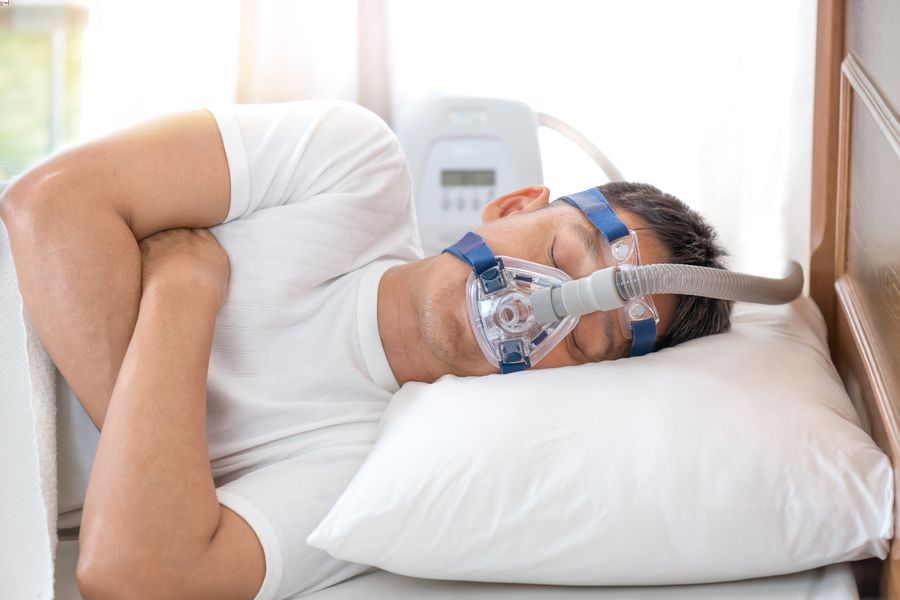Sleep Apnea Treatment
Sleep apnea is a disorder that can lead to serious complications, but is a manageable condition with treatment. The disorder is characterized by ceasing to breathe while sleeping and being woken up by the brain’s defense mechanism, preventing healthy sleep.
Several sleep apnea treatment options can help prevent an episode or reduce how many events occur during the night, but there is currently no cure for the disorder.


What is Sleep Apnea?
Caused by either a blockage of the airway or the brain’s poor breathing control during sleep, sleep apnea causes a person to stop breathing while sleeping. The lack of oxygen activates a survival reflex, waking a person up long enough to resume breathing properly and interrupting the sleeping cycle. The constant interruption can lead to extra stress on the heart and other conditions that can be life-threatening when not managed properly.
Sleep apnea is categorized into three levels of severity:
Mild: A person with an apnea/hypopnea index (AHI) that is between 5 and 15. This means they have between 5 and 15 episodes every hour during sleep.
Moderate: A person with moderate sleep apnea has between 15 and 29 AHI events per hour, meaning they stop breathing and/or wake up between 120 and 239 times.
Severe: More extreme cases of sleep apnea mean waking up 30 or more times in a single hour and stopping breathing over 240 times during an 8-hour sleep cycle.
Sleep Apnea Symptoms
Some sleep apnea symptoms can be difficult to detect while others are more apparent. Symptoms can include:
- Feeling tired or exhausted even after a full night’s sleep
- Snoring
- Daytime sleepiness/drowsiness
- Mood changes, such as anxiety and depression
- Disruptions in memory, concentration, and other brain functions
- Waking up in the middle of the night. Waking may be remembered as needing to use the bathroom or heartburn
- Unusual breathing patterns
- Sexual dysfunction
- Insomnia
- Headaches
- Night sweats




Treating Sleep Apnea
There are several approaches to treating sleep apnea, depending on the specific type and its severity. It’s important to note that no sleep apnea treatment cures the condition, but it helps prevent apnea events from occurring or reducing how often they happen.
Treatment options include:
- Conservative (nonmedical) treatments.
- Positive airway pressure and adaptive ventilation devices.
- Oral appliances (mouthpieces).
- Nerve stimulators.
- Surgery.
- Medications (central sleep apnea only).
Sleep Apnea Treatment Options:
Lifestyle Modifications
- Weight Loss: Losing excess weight can often reduce or eliminate symptoms, especially in cases of obstructive sleep apnea (OSA).
- Positional Therapy: Changing sleep position, and avoiding sleeping on the back, can sometimes alleviate symptoms.
Surgery
- Uvulopalatopharyngoplasty (UPPP): Surgical removal of excess tissue from the throat to widen the airway.
- Genioglossus Advancement (GA): Repositioning the tongue attachment to prevent airway collapse.
- Maxillomandibular Advancement (MMA): Repositioning the upper and lower jaw to enlarge the airway.
Bi-level Positive Airway Pressure (BiPAP)
Similar to CPAP, but with adjustable pressure levels for inhalation and exhalation. BiPAP is often prescribed for individuals who find CPAP uncomfortable.
Adaptive Servo-Ventilation (ASV)
ASV devices adjust air pressure based on the patient’s breathing patterns, providing support when needed.
Auto-CPAP (APAP)
Automatically adjusts the air pressure throughout the night based on the patient’s breathing patterns.
Oral Appliances (Mandibular Advancement Devices)
Custom-fitted dental devices that reposition the lower jaw and tongue to keep the airway open. These are often used for mild to moderate OSA.
Continuous Positive Airway Pressure (CPAP)
CPAP Machine: A common and effective treatment for moderate to severe OSA. It involves wearing a mask over the nose or both nose and mouth, which delivers a continuous stream of air to keep the airway open.
Inspire Therapy/CPAP Alternative
A surgically implanted device that stimulates the hypoglossal nerve to prevent airway collapse during sleep.
Nasal Devices
External nasal dilators or adhesive strips that help improve nasal airflow.
Positional Therapy Devices
Devices that help individuals maintain a specific sleeping position to reduce airway obstruction.
Supplemental Oxygen
Oxygen therapy may be used in some cases, especially for central sleep apnea or when oxygen levels are low.
